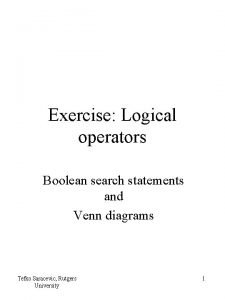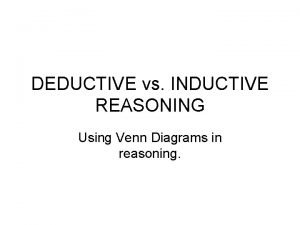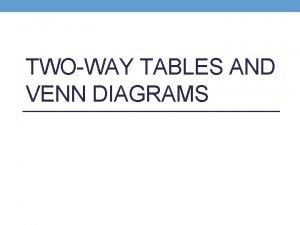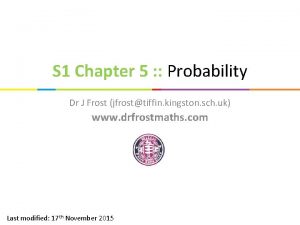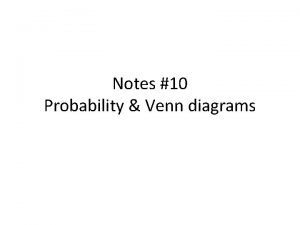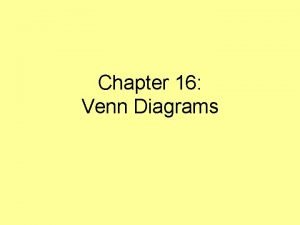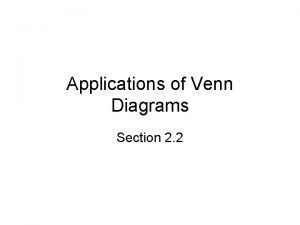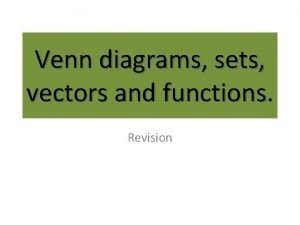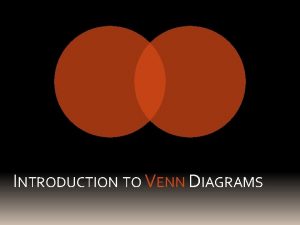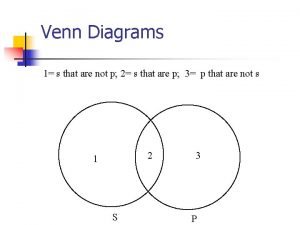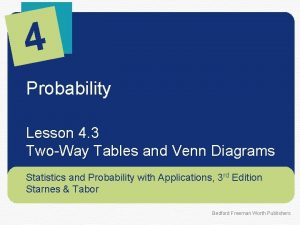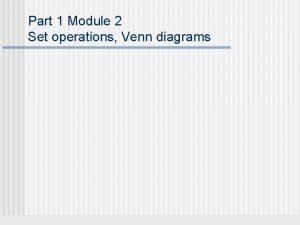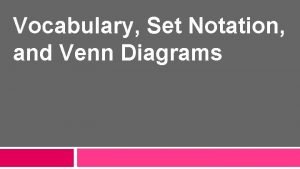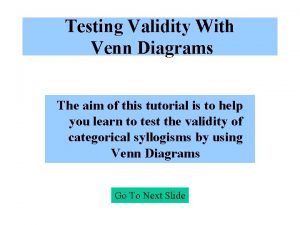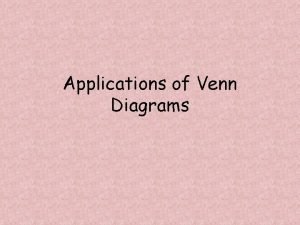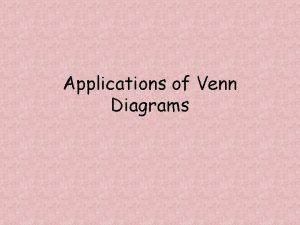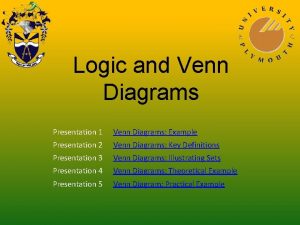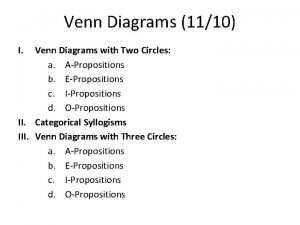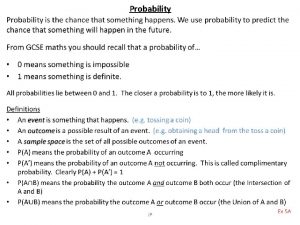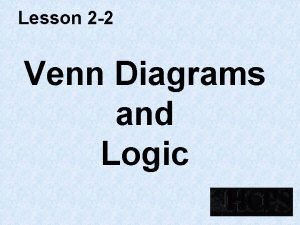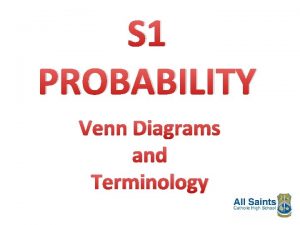Testing Validity With Venn Diagrams The aim of



















- Slides: 19

Testing Validity With Venn Diagrams The aim of this tutorial is to help you learn to test the validity of categorical syllogisms by using Venn Diagrams Go To Next Slide

Though they may look a bit confusing, Venn Diagrams are actually quite simple to use. The beauty of the Venn Diagram is that it allows you to determine whether a categorical syllogism is valid or invalid and to do so with absolute assurance. Since we know how important it is to be able to test the validity of syllogisms, it is worth the time to learn to use Venn Diagrams correctly. Go to next slide.

First, translate your syllogism into standard form. For simplicity, you may, if you wish, assign variables to each of the three terms. S CD All caffeinated drinks are stimulants. C All forms of coffee have caffeine. All forms of coffee are stimulants. All CD are S All C are CD All C are S Go to next slide.

A Venn Diagram consists of three overlapping circles which represent the three terms in the syllogism and their relationship with each other. CD C S All CD are S All C are CD All C are S For convenience it is best to be consistent in assigning terms to the circles. The subject term of the conclusion is assigned the lower left circle, and the predicate term of the conclusion is assigned the lower right circle. Go to next slide.

As you work through this tutorial, realize that what you draw in the Venn Diagram represents exactly what is in the premises of the syllogism; nothing more and nothing less. There are three steps in this process: CD 1. Draw premise one. 2. Draw premise two. 3. Check the validity. Go to next slide. C S

So, to represent “All CD are S” we focus on the CD and S circles only. Our rule is to shade EMPTY areas. Imagine that we don’t know how many things are inside these circles, or where exactly they are inside the circles, but we know that all the things in CD are also in S. CD C Go to next slide. S All CD are S All C are CD All C are S

Look at the first premise and then at the shading. Since we know all CD are in S, we know the rest of CD is empty. Now draw premise 2. All the items in C are also in CD. Thus the rest of C is empty and should be shaded. Go to next slide. All CD are S All C are CD All C are S

Now for step 3. We’ve drawn each premise exactly and can now check for validity. If valid, the conclusion will be shown in the drawing to be necessarily true. If the drawing allows for the possibility of the conclusion being false then the syllogism is invalid. What do you think? Valid or Invalid? Go to next slide. All CD are S All C are CD All C are S

This is a valid syllogism. The drawing clearly shows that the conclusion is necessarily true. All C are indeed S. The only area of C that is not empty is the part that is in S. Go to next slide. All CD are S All C are CD All C are S

R E All educated people respect books. Some bookstore personnel are not truly educated. Some bookstore personnel don’t respect books. B Translated into standard form All E are R Some B are not E Some B are not R Be clear that: E = Educated people R = People who respect books. B = Bookstore personnel Go to next slide.

All E are R Some B are not E Some B are not R E Ok, draw the first premise. All E are inside R, so we know that the rest of E is empty. We represent this empty area by shading it. B Go to next slide. R

All E are R Some B are not E Some B are not R E X Should the “X” go here? Now the second premise. We read “some” as “at least one” and represent it with an “X. ” So we want to put an X inside the B circle but outside of the E circle. X X B R Or here? We want to say exactly what the premises say, but no more. Go to next slide.

All E are R Some B are not E Some B are not R Think about it. If we opt for the blue X, we are saying “some B are not R, ” but this X? is not in the premises and we B can’t draw something that is not in the premises. Likewise the red X would say, “Some B are R, ” and this is not in the premises either. E X? R What we need is an “X” on the line which will mean that “some B” are on one side of the line or the other, or both, but we’re not sure which. Go to next slide.

All E are R Some B are not E Some B are not R So, having drawn exactly what is in the two premises and no more, is the conclusion necessarily true? Is it true that some B are not R? E X? B No, this is an invalid argument. The “X” shows that there may be some B that are not R, but not necessarily. Go to next slide. R

I M H No islands are part of the mainland Hawaii is an island. Therefore, Hawaii is not on the mainland. Translated into standard form No I are M All H are I No H are M Draw the first premise. Nothing that is an I is inside the M circle. So, all the things inside I, if there any, are in the other parts of the circle. Go to next slide. I H M

I No I are M All H are I No H are M Now draw the second premise. Everything that is in the H circle is also in the I circle. H Thus, the rest of the H circle is empty and should be shaded. Step 3 asks you to look at what you’ve drawn and see if the conclusion is necessarily true. Is it necessarily true from the picture that nothing in the H circle is in the M circle? Yes, this is a valid argument! Go to next slide. M

M C Some modems are cable connections and some cable connections are digital. Thus, some modems are digital. D Translated into standard form Some M are C Some C are D Some M are D Draw the first premise. At least one thing in M is also in C. Where should the “X” go? Do you see why the “X” has to go on the line? From the premise you can’t tell which side of the line is correct. Go to next slide. C X M D

C Some M are C Some C are D Some M are D XX Now the second premise. Where should M D the “X” go to represent ‘at least one’ C that is inside the D circle? Remember you want to draw just what the premise says, no more and no less. Again, the “X” must go on the line. Our drawing can never be more precise than the premise is. Is it Valid? No this is an invalid argument. There is no guarantee, from the premises that the conclusion is true. There may or may not be an M in the D circle. Go to next slide.

If you apply the step by step approach to using Venn Diagrams you will quickly become an expert. Keep these things in mind: 1. 2. 3. 4. Put your syllogism in standard form first. Be consistent in how you draw your diagram. Draw each premise exactly. Test validity by looking for the necessity of the conclusion. Want more interactive practice? Link here. This is the end of this tutorial.
 Criterion validity vs predictive validity
Criterion validity vs predictive validity Use case model
Use case model An activity diagram is a static model.
An activity diagram is a static model. Boolean venn diagrams
Boolean venn diagrams Example of deductive argument
Example of deductive argument Mudlark airlines has a 15-seater commuter
Mudlark airlines has a 15-seater commuter Gcse venn diagram
Gcse venn diagram Dr frost maths venn diagrams
Dr frost maths venn diagrams Venn diagram probability
Venn diagram probability Categorical syllogism venn diagram examples
Categorical syllogism venn diagram examples Applications of venn diagrams
Applications of venn diagrams Complete the venn diagram.
Complete the venn diagram. Venn diagram for a union b whole complement
Venn diagram for a union b whole complement Introduction to venn diagram
Introduction to venn diagram Conditional probability with venn diagrams
Conditional probability with venn diagrams Lesson 4.3 two way tables and venn diagrams
Lesson 4.3 two way tables and venn diagrams A-b venn diagram
A-b venn diagram Deductive reasoning venn diagrams
Deductive reasoning venn diagrams Venn diagrams gcse
Venn diagrams gcse Set notation and venn diagrams worksheet answers
Set notation and venn diagrams worksheet answers



